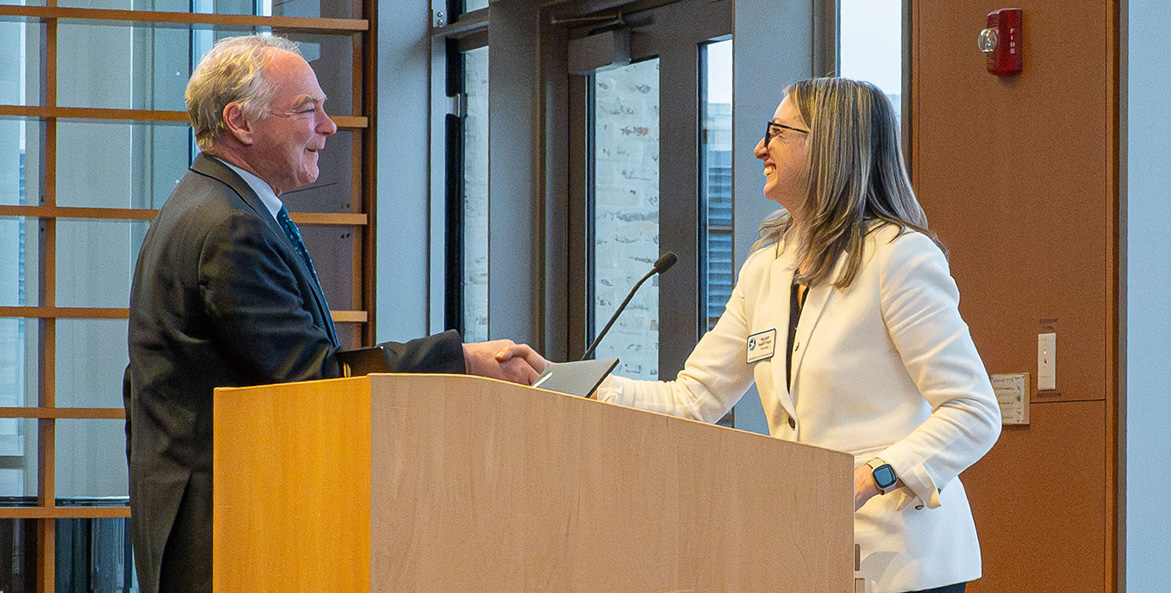After reading through the appropriations process, explore these stories of how federal dollars are at work in our communities.
Step 1 - The President's Budget
Every year the president submits a budget request to Congress, typically in February. A new president’s first budget often arrives later, as the new administration gets up and running. The president’s budget does not carry the force of law. However, the funding levels it proposes do reflect the administration’s priorities. The president’s budget is either viewed by Congress as a starting point or is disregarded altogether, depending on which party holds the White House and which party or parties control Congress. CBF and our advocates work throughout the annual appropriations process to ensure that programs essential to Bay restoration are robustly funded.
Step 2 - Congress' Budget
Through the spring, the House and Senate Budget Committees work to pass the congressional budget plan (called a “concurrent budget resolution”). It includes budget targets, policy priorities, and specific funding levels for different government functions—including those that support Bay restoration. Like the president’s budget, the congressional budget plan is not law. But it does set important spending and revenue levels for Congress, including how much money the Appropriations Committees will be allocated to fund discretionary government programs in the coming fiscal year. The federal fiscal year starts October 1.
Step 3 - Appropriations
The House and Senate Appropriations Committees each have 12 subcommittees that write the annual budgets for the federal departments and agencies under their jurisdiction. These subcommittees hold hearings to hear from both experts and from members of Congress directly about their priorities for the bill the subcommittee will write. Once the subcommittees draft and vote on their respective bills, they pass their legislation to the full Appropriations Committees for debate and approval.
Advocates and members of Congress from the Bay region can make a real impact during this part of the budget process. This is a key time for advocates to contact members of the relevant subcommittees and urge them to include robust funding for Bay restoration in their spending bills. CBF also works with our congressional representatives and senators from Maryland, Pennsylvania, Virginia, Delaware, West Virginia, New York, and the District of Columbia to write to congressional leaders and senior members of the Appropriation Committees requesting sufficient federal funding for restoring the Bay and its rivers and streams.
Once a spending bill is approved by the Appropriations Committee it goes to the floor of either the House or Senate for debate and consideration of amendments. All representatives or senators have the opportunity to offer amendments and vote on them when a bill is on the House or Senate floor. CBF monitors this stage closely. CBF tracks amendments and, when needed, mobilizes advocates to urge their representatives or senators to defeat amendments that would hinder Bay restoration progress.
After each chamber passes its version of a bill, negotiators from the House and Senate reconcile any differences between the two versions and produce a compromise bill. Both chambers must pass the compromise bill before Congress can send it to the president to sign.
If Congress fails to pass final spending bills for the coming fiscal year by September 30, the last day of the current fiscal year, it must still fund government programs in the new fiscal year, which starts October 1. Otherwise, government agencies covered by the outstanding bills may be forced to shut down. To avoid a shutdown, Congress can pass what’s known as a “continuing resolution.” A continuing resolution extends funding levels from the fiscal year that just ended until a certain date in the new fiscal year. This “deadline extension” gives Congress more time to finish work on the overdue bills.
Step 4 - Reconciliation
Sometimes the budget resolution requires Congress to amend laws that directly fund certain programs to meet its budget targets. This process does not involve Appropriations Committees because the programs it covers are not funded annually through appropriations. Instead, the committees with jurisdiction over the affected laws draft legislation to amend those laws so they produce the revenue or spending level set in the budget resolution. The Budget Committees then package together all of the bills the other committees drafted to carry out the budget resolution’s instructions. Both chambers then must pass their respective budget reconciliation bills, reconcile any differences between them, and pass a final compromise bill that will become law if the president signs it. CBF carefully follows the reconciliation process and is ready to respond to—and engage advocates and lawmakers if necessary—any proposals that would undermine Bay restoration work.
Federal Dollars at Work
-

Two Childhoods, One Bay
May 23, 2025
From flaming rivers to cleaner air, explore how 55 years of environmental action—and inaction—shape the world our children inherit.
-

There’s No Place Like Home … for Environmental Learning
May 21, 2025
Pennsylvania teachers are getting students outside and learning about their local environment thanks to a NOAA grant. But Trump’s proposed budget cuts threaten to take this critical program away.
-

The Trees That Never Were
May 13, 2025
Deanne Boyer's plan to plant trees and expand a streamside buffer on her farm would have had multiple benefits. But the federal government stepped in and then stepped out.
-

Harnessing the "Little Bivalve" to Produce Big Results for the Bay
April 11, 2025
Federal investment in large-scale oyster restoration in the Bay's rivers provides support for community efforts and is reaping benefits downstream.
-

Federal Funding Freeze for Pennsylvania Farmers Is a Blow to Momentum for Cleaner Waterways
April 1, 2025
The federal government has frozen grants awarded to Pennsylvania farmers, leaving behind unpaid contracts, people out of work, and obstacles to reducing pollution to local waters and the Chesapeake Bay.
-

An "Amazing Gift" of Land Conservation
March 31, 2025
How a WILD grant helps protect land, create legacy, and complete a conservation puzzle in West Virginia’s Potomac River headwaters. As Congress goes through the appropriations process in the coming months, we must remember how vital this federal funding is.
-

We Must Go On
March 24, 2025
I had the opportunity to speak with Senator Tim Kaine at our event “Climate Change: Keeping Our Community Safe and Prosperous” as part of our Brock Climate Lecture Series.
-

What’s the State of Bay Restoration 50 Days into the New Administration?
March 14, 2025
CBF’s Federal Director gives a frank update on the current chaos in our nation’s capital and what it means for Bay restoration efforts.
-

EPA’s Chesapeake Bay Program Grant Sparks Healthy Living Movement at Richmond Church
March 13, 2025
Second Baptist Church is just one example of a project that improves community, health, and water quality and is only made possible through funding from EPA.
-

Restoration Grants do Double for Delaware Town and Bay
December 19, 2024
Projects to fight stormwater runoff and shoreline erosion are all part of the bigger picture in Laurel, Delaware.
-

Keeping West Virginia's Water Wild, Woolly, and Wonderful
August 15, 2024
A West Virginia couple's dedication to protecting the headwaters of the Lost River and reforesting part of their farm are helping downstream brook trout and improving water quality from the headwaters of the Potomac River to the Chesapeake Bay.



